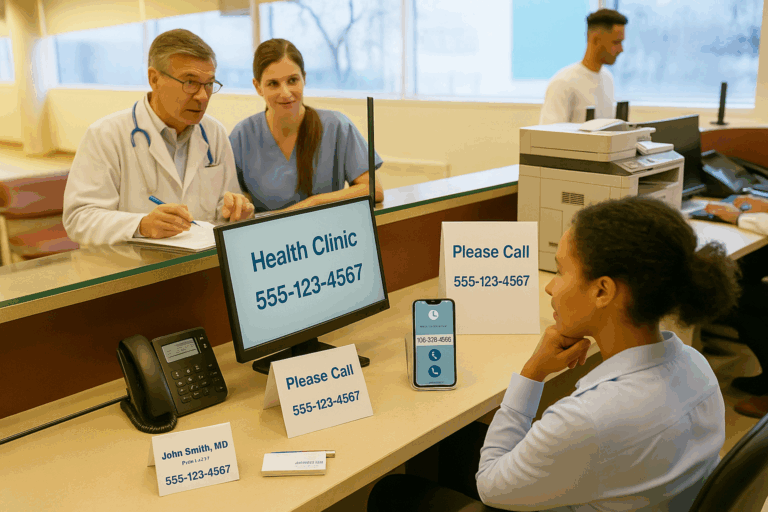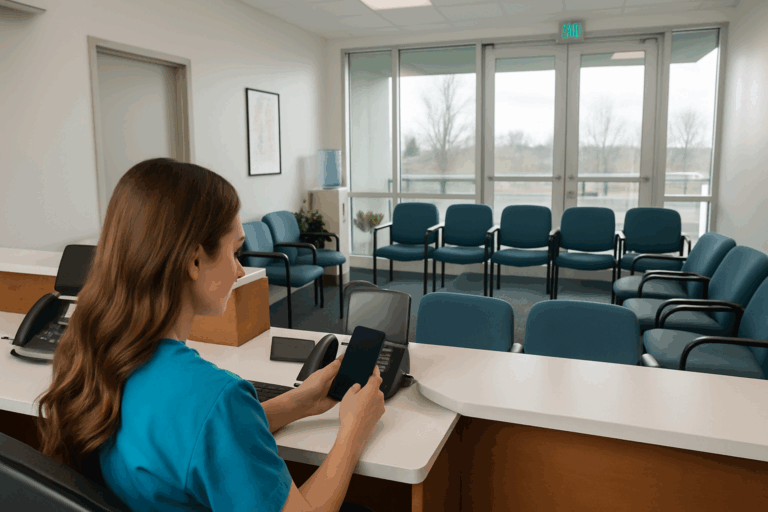Having spent decades in an industry that manages how people connect, communicate and inform each other through the technology of modern phone systems, I’ve developed what some may consider an academic-level expertise on the simple things that offices can do to make the people calling feel attended to, cared for and at ease. When it comes to patients using the phone as a way to reach their doctors – most of the time around a concern – I’ve especially enjoyed working with hundreds of physician’s practices and healthcare systems to personalize and customize their healthcare communication system to improve patient care.
Here are my 10 tips to help many more doctors’ offices to improve the quality of patient care:
Use Your Team Wisely: Make sure the patient calling in by phone can get a live person easily.
The reasons for this are something we all know as a consumer: When the service is personal, we usually feel more comfortable talking to a human to help handle our needs. With healthcare being the most personal of all services, it’s a basic tenet of the healthcare communication that callers are going to want to talk to someone. It’s not critical you answer every call with a live voice on the first ring – everyone understands how businesses operate these days – but it’s imperative that a patient can access a warm voice easily.
There are two main options for helping patients get a live person quickly and easily: You can either answer all calls live without having the caller go through a menu, or you can have a well-designed menu with easy access. There are upsides and downsides with each. But with some preparation and planning, either one can work well. The right decision, of course, is whatever is right for your office with the resources you have and the amount of call traffic you expect. It’s actually a simple process that determines how either option can be done right. If you choose to answer all calls live, the trick is to make sure all staff understands the importance of this responsibility and are motivated to answer calls promptly and practice professional phone etiquette. This is important in both cases, but when calls are answered live, patients can be turned off if the person answering is inattentive or unprofessional.
The alternative to answering everything live, of course, is to utilize a menu. Here at RingRx, we are strong advocates for using menus. But we do caution our clients that they should be done in a way to optimize the caller’s experience and not just to make it easier on the staff. Both of these issues are important, of course, and the improvement to productivity is without a doubt a critical factor. But in the end, the patient should have a good experience, and that means they need to feel well taken care of.
The first rule in healthcare communication of having a menu is to make it easy to get a live person from one of the first few options on your menu. This way, patients don’t feel like they are being sidelined to save the office a few seconds of time. However, people are used to menus nowadays and many people will even prefer using them if they know what department or extension they need. Another great thing about the menu is you can control the quality of the voice recordings so patients feel welcome – a trait that is hard to maintain 100% of the time even for the best-trained and caring phone staff. But make sure that a patient can reach the front desk quickly if they know that is what they need. Otherwise, they just feel managed. We frequently reserve the very-common “press-zero” option since many people will try it anyway. Another option is to use 1 to access the front desk.
Give Options: Use a menu, but do it right.
For most offices, the decision to use a menu is mainly a function of how busy the office is. The more providers, the more patients, the more general the practice is, the more likely you will choose to use a menu. And you will undoubtedly learn, providing callers a menu is a great way to help improve the efficiency of your office. The challenge here is to do it in a way that actually makes your patients feel like they are being better served by having a menu than not. Consider these options:
- Have it professionally recorded.
- Keep it focused. Avoid using all 9 options unless you have to.
- Use dial by directory – but use it on a sub-menu. Reserve the main menu for the 5 most important general options.
- Provide an option for patients to get your fax number, office hours, address, directions, a general email address, and names of physicians.
- Give an option at the end to repeat the menu, or repeat it automatically.
- Change up your menus for office hours and after hours. Make sure staff can get the resources they likely will want after hours. This, of course, includes an option to reach the on-call provider. But also important is a convenient way to cancel or reschedule an appointment or to request medical records.
- And most importantly, give an option for callers to get a live person quickly (see #1)
Be Original: Music on Hold
There’s a quote by Bob Marley that goes something like: “One good thing about music, when it hits you, you feel no pain.” Consider this now from the perspective of your patients who are trying to get relief from pain when they call you.
If you are like me you wonder if there are only two or three music-on-hold tracks that play in about 90% of all offices in the country. Well, that is of course not true, but it sure seems that way. Maybe it’s because 90% of them are just plain bad or should be restricted to being played in elevators of department stores. Which brings me to the one rule we have with music-on-hold is this: it can’t offend anyone.
Unfortunately, that is not always very easy. In fact, it seems some people are offended even if they don’t particularly hate the music, but that they think the music is enjoyed more by someone other than them. In any event, we approach music-on-hold a bit differently than most companies.
We like to make sure the music-on-hold is not just pleasant, but that it has the right personality for your office. Spend a few minutes pondering what your office personality is and what kind of music pops into your head. Now think of a few songs that you like that fit that bill or browse around the web listening to things you think are a good match. Maybe pick 2 or 3 tracks and have the best selections cut out and blended together with the other tracks. It’s a good idea to adjust the audio volume by “fading” between songs to avoid any odd-sounding changes.
One solid way to set yourself apart is to have a message recorded that plays over background music that was picked for your office. If you choose, hire a voice talent to add some messaging, just make sure the music feels right in the background.
Use Time Wisely: Consider a message on hold.
But it should be professional and give information the patient wants to hear, not just a promo about something you are selling. The main healthcare communication guideline here is if you choose to have some marketing messages, mix it up with something more benign or something interesting about your office. Perhaps the background of the doctor and something unique about the office. Upcoming events and news items are great, but it requires more management to keep the information fresh. If you do choose to include marketing and promotions, avoid anything too heavy-handed to keep the patient-experience fresh and the main focus.
Consistency is Comforting: Use an “approved” answer phrase when a phone is answered live.
Train staff to use the phrase consistently and remind them of the importance of answering professionally and politely. A good way to underscore the importance of answering the phone properly is to point out that the call they answer may be the only call that patient makes that day, especially if they are elderly. While your staff will undoubtedly answer dozens of calls in a day, the experience the patient has is substantially affected by the way the front desk staff sounds on the phone.
Non-Emergency Choices
If you use an answering service after hours, give your patients an option to leave a voice message on your office phone system if it is not urgent.
It is becoming much more accepted and preferred in healthcare communication to leave a confidential message than talking to someone at an answering service. Plus answering service staff should be reserved for what you really have them for: Urgent calls. This will also keep your answering service bill low, as most services charge by the amount of time they are on the phone or by the number of calls they take. Plus it avoids the occasional late-night mistake of calling the on-call doctor for something that was not urgent.
Communication is Key: Use high-quality desk phones. Don’t go cheap – quality matters.
There are dozens of phone manufacturers on the market and the quality and features vary quite a bit. Given the fact that your front desk staff is on the phone so much, the additional cost of getting the highest quality phone with the most appropriate features is minimal when factored in over the life of the phone. Most service providers offer good financing options for new phones, so if you want to avoid large capital outlay, consider a lease option on a good phone.
Script it: Have a standard format and script layout for staff greetings on voicemail boxes.
Make it cheerful yet professional. Print the script out so staff have it readily available if they need to change their own greeting. After a staff records a new greeting, have it reviewed by a manager to make sure it is consistent with other greetings in the office Phrases associated with common courtesy go along way to cement your reputation as a caring office with good service.
Move Ahead of Standard: Implement advanced healthcare communication features.
Call Park Orbit, Direct Call Pickup, Ring Groups, and Intercoms can help improve the patient experience by reducing the time it takes for them to be served. It is also great for staff efficiency, so these can be a win-win when implemented properly and used appropriately. Training on these is minimal, but the improvement to the patient experience is high.
Check-in: Call your phone once in a while.
Try for yourself these healthcare communication tips and see how it sounds and flows. Encourage management to do the same. Make changes accordingly and don’t be afraid to try new things and see how patients respond.
Are you ready to open up new lines of communication with your patients and increase practice efficiency? Click here to start your free 30 day trial of RingRx. We provide a signed BAA upon the start of service.




